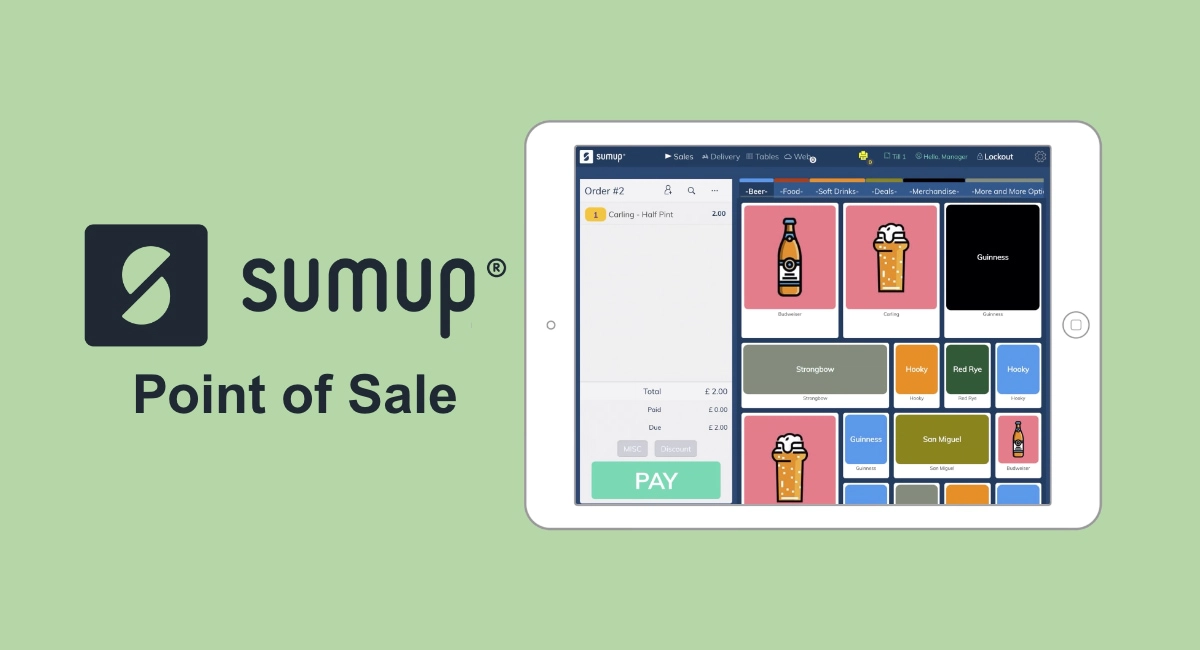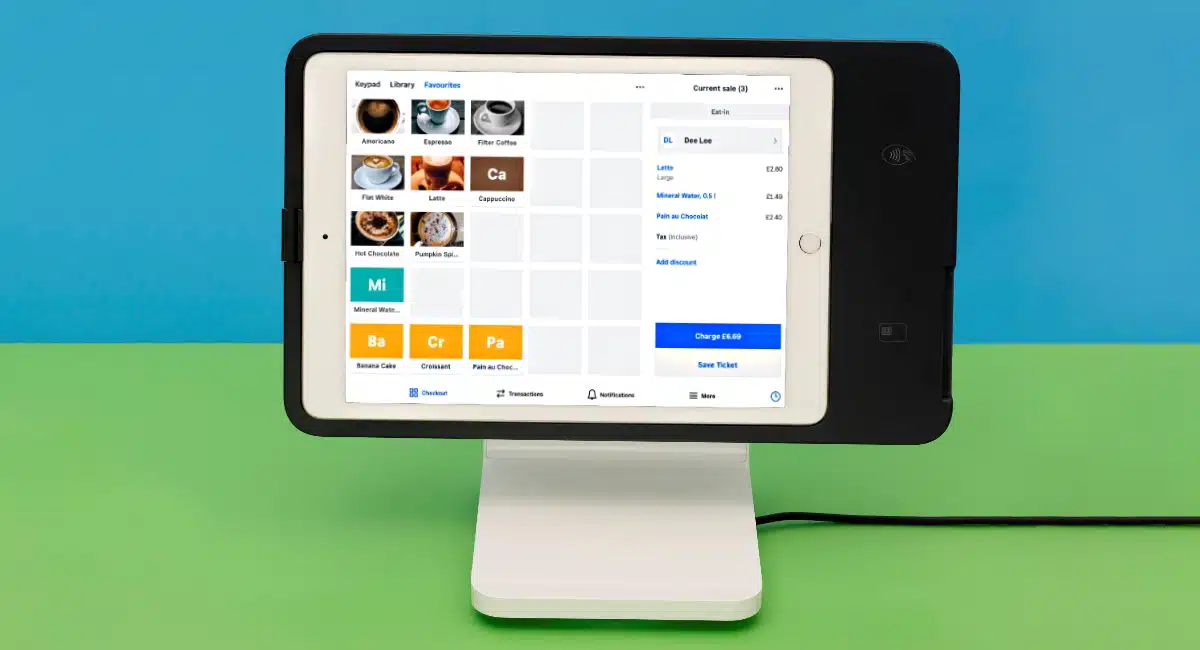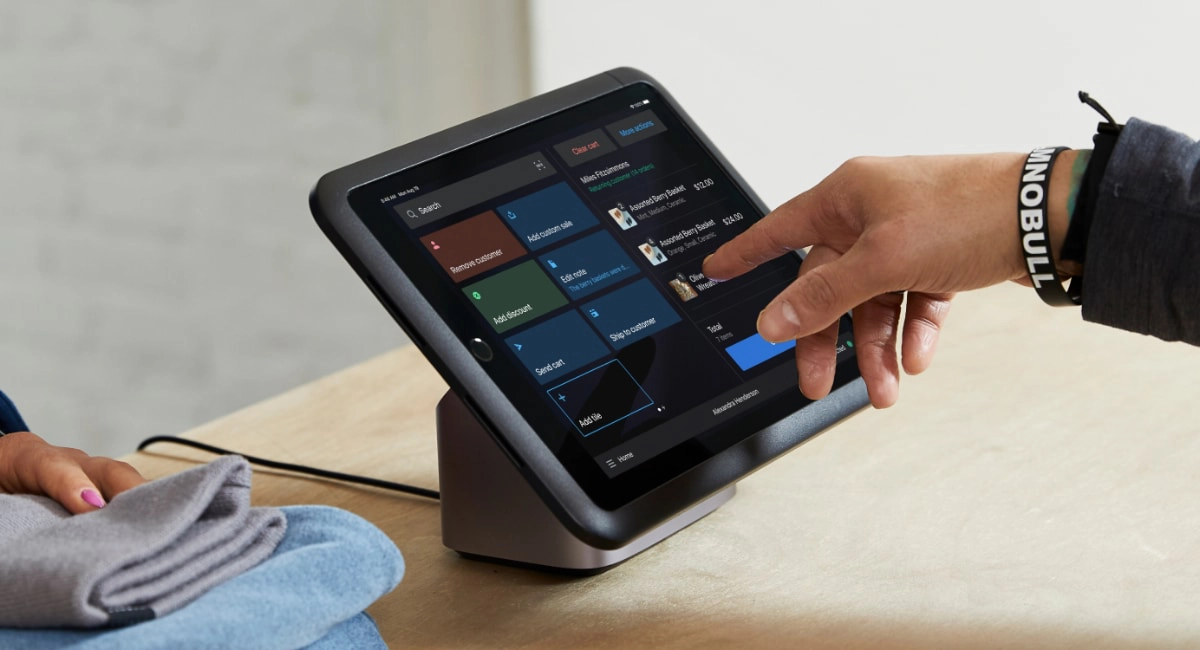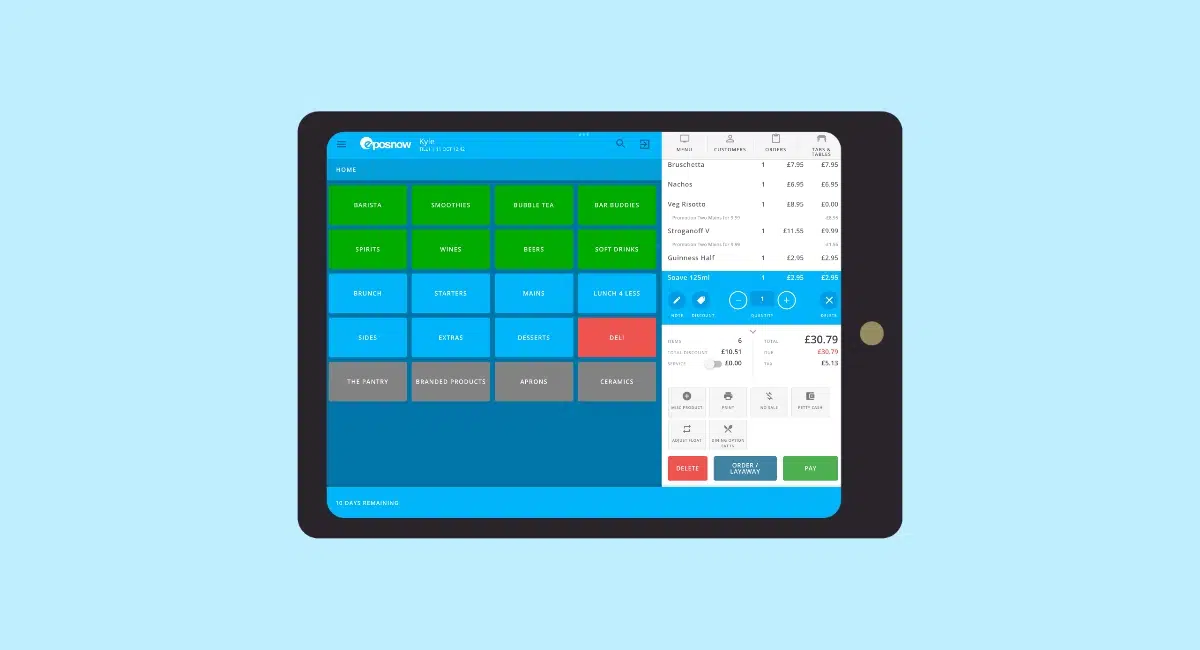- Highs: Affordable. Online ordering features included. Offline mode. Choice of add-ons. Not too complicated.
- Lows: No Android app. Trial only for Core POS and Hospitality. Incomplete help resources. Some bugs. 12-month contract.
- Choose if: You’re a SumUp user and want the cheapest, most convenient POS upgrade.
What is SumUp Point of Sale?
SumUp Point of Sale is the new name for the iPad POS system that used to be Goodtill. In 2020, SumUp acquired Goodtill and is still in the process of rebranding it completely.
The POS system is built for retail and hospitality. It works like this: you must subscribe to the Core POS module containing features for any type of business. Then you choose add-on ‘modules’ for specialised features applicable to your particular business, for example the Hospitality module.
The final monthly cost depends on how many modules you need for your business. An online ordering module is included free.
The POS software does not only work with the SumUp card reader, it also works with Zettle and other select card processors.
Pricing
SumUp Point of Sale requires a year’s subscription initially, after which there’s a 90-day notice period. This means you’ll continue to be charged for 3 months after your notice. This is at odds with other monthly-charged POS systems that let you cancel the same month.
To be sure of whether SumUp POS is right, you can sign up for a 30-day free trial, which only includes the Core POS and Hospitality modules. After the trial is up, you must subsequently subscribe to Core POS for £29 + VAT per month.
You can then choose to add a mix of modules at different price levels (table below), from e.g. Hospitality for £9 + VAT per month to Business Analytics for £29 + VAT per month.
| SumUp POS software | Cost* |
|---|---|
| Core POS module | £29/mo per till |
| Optional modules: Hospitality, Kitchen Display Screen (per screen), Uber Eats Integration, Deliveroo Integration | £9/mo each |
| Optional module: Ecommerce Integration | £10/mo each |
| Optional modules: Advanced Stock, Promotions, Loyalty | £18/mo each |
| Optional module: Business Analytics, ResDiary Integration | £29/mo each |
| Goodeats | No monthly fee 1.7% +12p for table orders, drop-offs 2.7% + 12p for collect, delivery orders No charge for first £1k of transactions |
*Excluding VAT.
| SumUp POS software |
Cost* |
|---|---|
| Core POS module | £29/mo per till |
| Optional modules: Hospitality, Kitchen Display Screen (per screen), Uber Eats Integration, Deliveroo Integration | £9/mo each |
| Optional module: Ecommerce Integration | £10/mo each |
| Optional modules: Advanced Stock, Promotions, Loyalty | £18/mo each |
| Optional module: Business Analytics, ResDiary Integration | £29/mo each |
| Goodeats | No monthly fee 1.7% +12p for table orders, drop-offs 2.7% + 12p for collect, delivery orders No charge for first £1k of transactions |
*Excluding VAT.
Its online ordering module, Goodeats, does not have a monthly fee, but online transactions through it have a charge of 1.7% +12p per table order or drop-off, or 2.7% + 12p per order for collection or delivery. The first £1,000 accepted through Goodeats does not incur transaction fees.
Card payments incur separate charges through your chosen payment processor. Although SumUp prefers you to use its own card reader, SumUp Air (£39 + VAT), you can integrate with any card machine from its list of compatible providers.
Setting up and ease of use
Before you subscribe, you can sign up for a 30-day free trial on the Goodtill website. You’ll need to do this online and not through the app. The sign-up is pretty quick and simple – it’s mainly about choosing a username and password and providing basic contact details.
Your account is created immediately, after which SumUp asks for more detailed business information and leads you to the Backoffice account (browser-based).
You won’t be able to test the POS app until you’ve added products, settings and main information to your account. This could take a little while, since it’s not clear in the dashboard where to begin. The most user-friendly POS apps on the market tend to have a step-by-step guide to help you get started quickly, whereas SumUp Point of Sale only points you to an intro video.
You are also encouraged to get in touch with one of their onboarding staff to help with setup and learn about the software. If you’d rather get on with it on your own, there’s a support chat in Backoffice that can point you to the right guides in their (incomplete) POS resource section.
We tried to find answers to different queries without luck and got in touch with support through the messaging chat. In all cases, we were referred to an email address since the support staff didn’t know the answer. This could be an issue when you just want to get started quickly, especially as there are few explainers in the Backoffice interface.
POS features
Rest assured: the Core POS module is a complete POS system on its own. If you work in hospitality or retail, however, you will most likely need the corresponding add-on modules too. Let’s look at what you’re getting.
Checkout options: This is part of the Core POS module. The checkout screen in the app shows the product layout, categories (in separate tabs) and a left-hand view of the current, itemised bill. You’ll need to edit the product screen in the back office – this cannot be done in the app.

SumUp Point of Sale till interface on iPad.
You can add a £ or % discount, allergens, customer details and whether the order is for eat-in or takeaway (if selling food). Orders can be saved, voided, registered as a ‘no sale’, marked as waste or petty cash. Items can be manually entered with a custom description and VAT status if it’s not already in the items library.
An ‘Options’ side menu lets you click in or out, close the register, access saved sales and previous transactions. You can refund from here either through scanning the barcode of the receipt or searching through past sales and select the item to refund.
Image: Mobile Transaction

Payment methods in the SumUp POS app.
Payment process: You can accept and track cash, cards, orders on account, gift cards, vouchers or other means.
It gives you an option to accept payment over the phone, but you’ll need to handle this through your chosen payment processors because the till app only gives you the option to register it as ‘Phone’. The same applies to tapping ‘Other’, ‘Gift Card / Voucher’, ‘Account’ on the payment screen – there is no screen for entering a reference number, so you’ll need to have a system for tracking these yourself.
With an integrated card machine, the POS app will work in conjunction with it for a smooth checkout. If integrated with SumUp payments, the POS app connects with the Air card reader and allows you to send payment links or generate a QR code for the transaction directly on the screen.
Receipts: The till app lets you send an email receipt after each sale or print a sales receipt through a connected printer. We’ve seen reports from users that the app automatically prints a receipt every time, even when you tap that it’s not needed, so you can’t actually save on receipt paper until this bug is fixed.
Image: Mobile Transaction
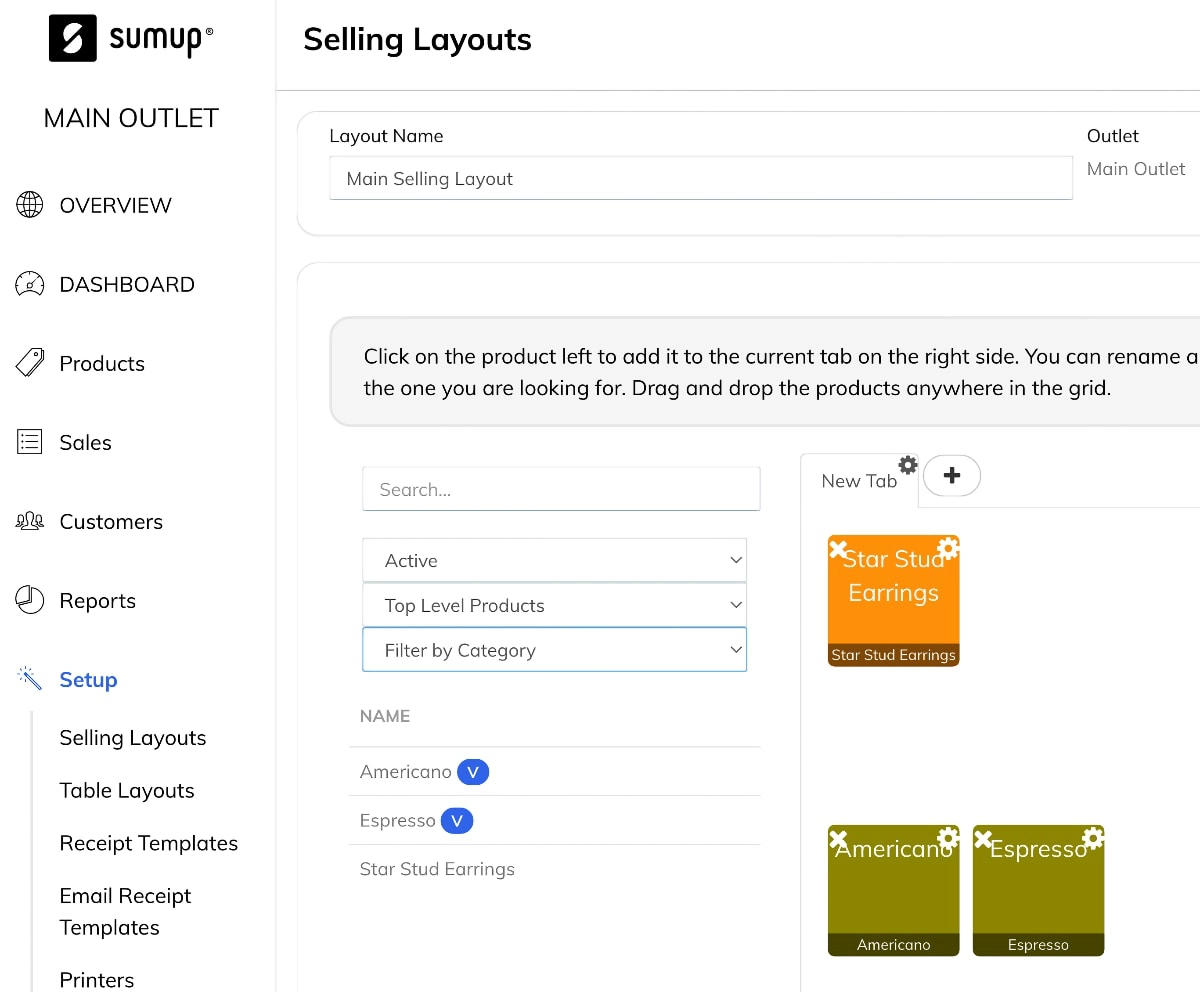
It could be more intuitive to create a till layout in Backoffice.
Inventory library: With the Core POS module, you have basic product management capabilities. This includes stock levels, low stock notifications, supplier lists, bulk product import and a detailed items library.
Each product can be attached to a category and have variants, attributes (added layer of variants), modifiers, tags, SKUs, VAT rates, an image and more. After products are added to your account, you can add them to the till interface through the slightly clumsy ‘Selling Layouts’ in the back office.
If you subscribe to Advanced Stock, you get more advanced features like:
- Multi-site support
- Integrated and automated purchase orders
- Delivery scheduling
- Stock variance reports
- Wastage reporting
- Stock auditing
Customers and loyalty: The Core POS module allows you to add customers with contact details to a list, divisible into customer groups. If you already have a spreadsheet of people, they can be uploaded to the system to save time.
With the additional customer loyalty module, you can run a points-based loyalty programme through an app. This works in conjunction with the customer directory.
Hospitality: The Hospitality module provides food-and-drink features like ingredient-tracking, course, cover and menu management with recipes, table plans with timers, customer tabs, split bills and a connection with the kitchen.
Image: Mobile Transaction
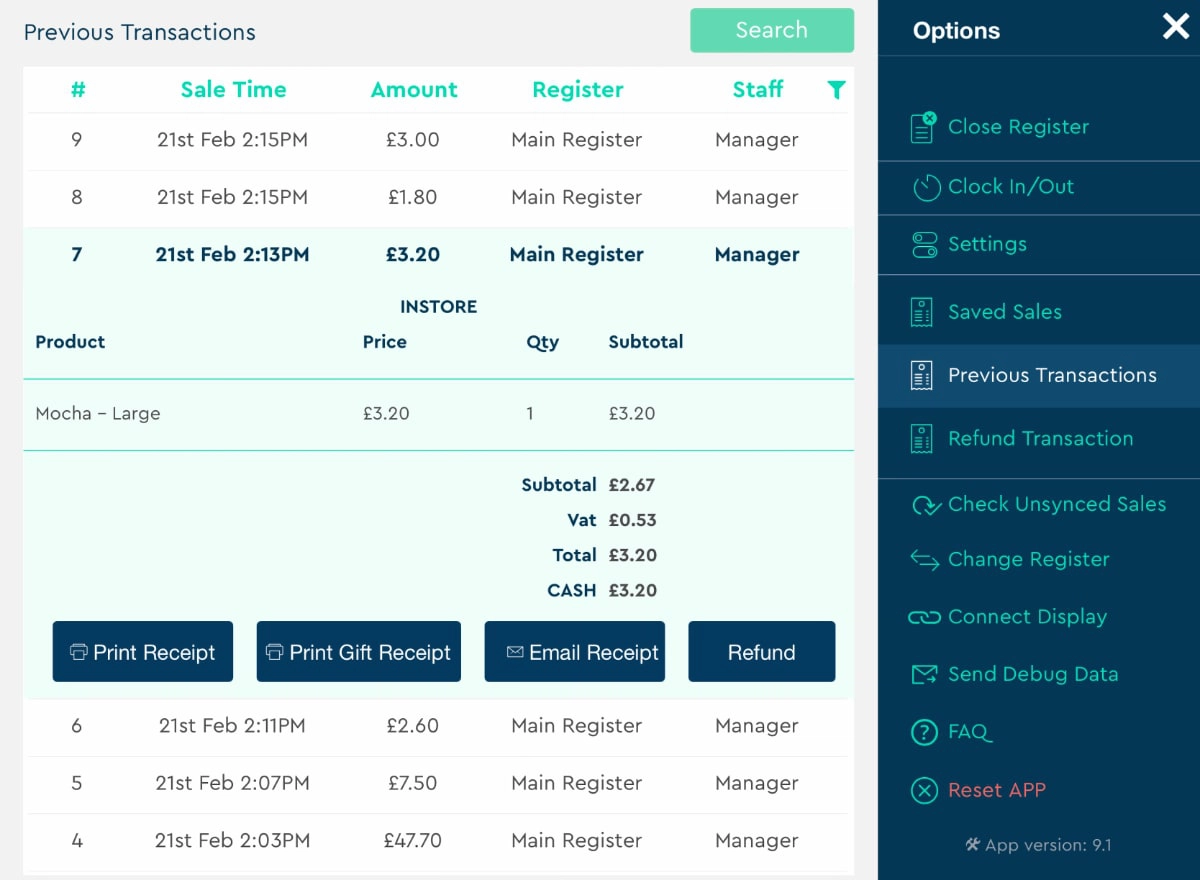
View transactions and refund items through the app’s ‘Options’ side menu.
Employee management: Add employees to the system with custom permissions, a passcode (for till logins) and an image. When users then log in and out of the till, you can track these work hours through the back office. It’s also possible to add more than one admin with access to all settings, and import staff from a spreadsheet.
Offline mode: Not all iPad POS systems work offline, but SumUp Point of Sale does. This makes the app very reliable, although card payments and certain features do require an online connection. Even when online, you have to refresh the app manually to view changes submitted in the back office. This is not very intuitive for front-end staff who have no idea when their manager has made changes in the backend.
Reporting: The Core POS plan contains enough reporting to monitor sales and search transactions. The core analytics are not that advanced, though. For more, you need to subscribe to the Advanced Stock, Hospitality or Business Analytics module.
The core app also monitors the cash flow so you can cash up at the end of the day. When you close the register, you get a complete summary of all the day’s main details around cash, sales categories, payment methods and till movements.
The daily sales so far (X report) have to be printed, though – they cannot just be viewed on the app screen – which is a peculiarity since not everyone wants to use a printer just for a quick glance.
Card machines and till equipment
Since SumUp owns the POS software, you’ll be encouraged to purchase a SumUp Air reader to use in conjunction with the app. There is usually a bundle on offer with an iPad, tablet holder, receipt printer, cash drawer and SumUp Air terminal for less than 50% off. You may even get a reduced transaction rate (we were offered 1.25% reduced from 1.69%).
Alternatively, you can integrate with card machines from:
These have their own costs and contractual terms, sometimes requiring a commitment of several years depending on the package.
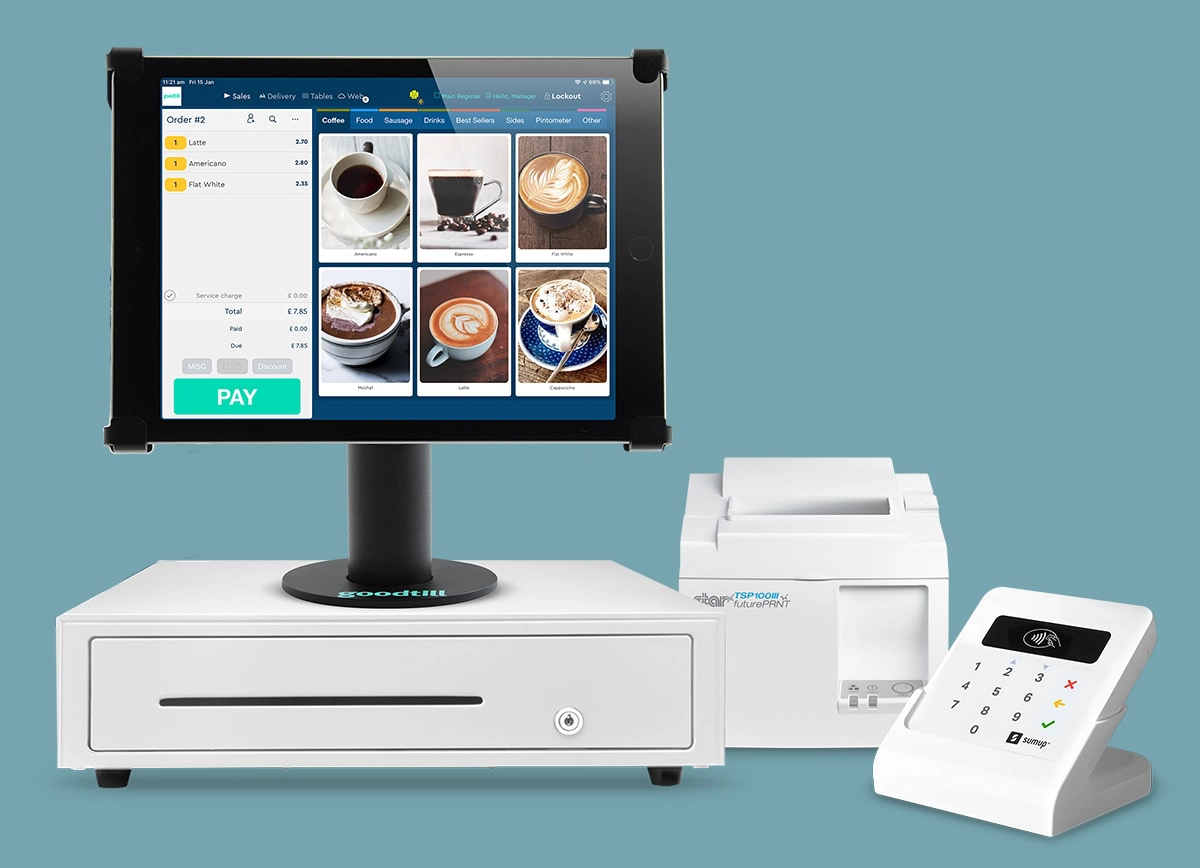
Example of a SumUp Point of Sale hardware bundle.
The system works with different hardware setups to suit your business, including barcode scanners and kitchen printers. The only downside is lack of Android or PC/Mac support for the POS interface. You have to use iPad for the till app – but then again, many cloud-based POS systems rely on iPad nowadays.
Online ordering: Goodeats
All users get free ‘Goodeats’ features to accept orders online. This is basically an online web page through which you can accept click-and-collect, delivery or drop-offs remotely.
The online transactions through Goodeats are processed by Stripe, so you’ll need to sign up and connect with Stripe. You decide on a URL, style choices, ordering options and other details displayed on the ordering web page. The URL can then be shared online via social media, Google My Business, your website or elsewhere you want to promote it.
QR codes can be printed and displayed on your tables or in your windows, allowing customers to place orders without staff interaction. The system can also be integrated with the Stuart delivery service.
Integrations
In contrast with SumUp App’s closed-loop, basic software, SumUp Point of Sale connects with a range of external software platforms for additional functions.
If the built-in Goodeats is not enough to sell online, Shopify and WooCommerce are ecommerce platforms that sync with SumUp Point of Sale. This requires an Ecommerce integration module for £10 + VAT monthly, in addition to the Shopify or WooCommerce costs.
QuickBooks, Xero and FreeAgent sync with SumUp so you don’t have to export sales data to manually feed into your chosen accounting program.
Restaurants would benefit from the integrations with Kitchen CUT, ResDiary (requires a £29 + VAT monthly integration module) and Fourth Hospitality.
Other integrations include MailChimp for email marketing, Zapier for automation features and Yoyo for customer loyalty tools. Employee tools can be expanded through Rotaready, Workforce or Planday. The NearSt integration also allows you to display products in Google or Facebook search results.
If this does not cover everything for you, you can use APIs and webhooks for your own software arrangement.
Photo: SumUp
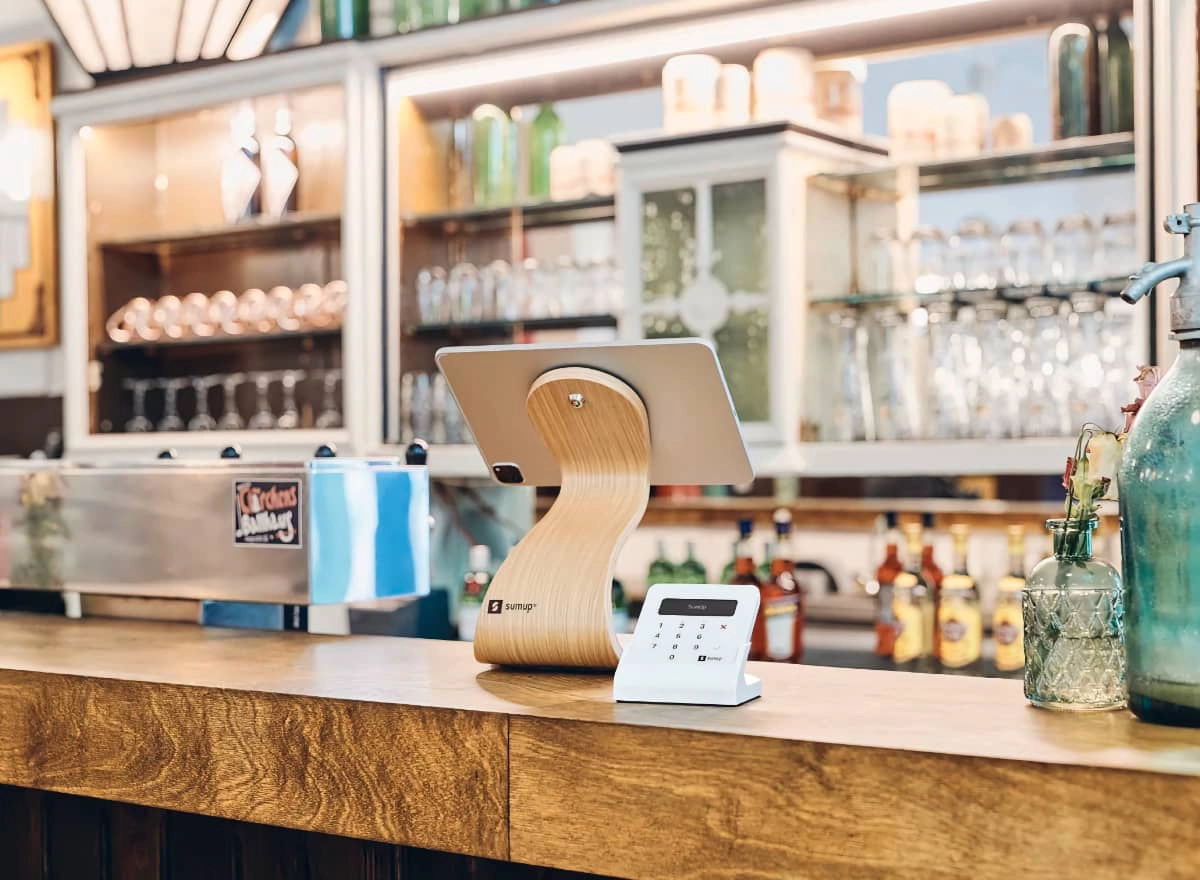
SumUp iPad stand and Air reader in a bar.
Customer service, reviews and experiences
SumUp’s customer support for Point of Sale users is available every day of the week by email and telephone: Monday-Thursday between 8am-7pm, Fridays between 8am-9pm, Saturdays between 10am-9pm, and Sundays and Bank Holidays between 10am-6pm.
The extended hours on Fridays and Saturdays are useful for the social hours of bars, pubs and restaurants, but 9pm isn’t late for these places either. The lack of personal support for emergencies past 9pm could therefore be an issue.
It is still limited how many reviews from users you can find since Goodtill’s rebrand to SumUp Point of Sale. Previous reviews suggest a limited user base that is largely positive, with some emphasising an unreliable customer support.
Our own experience has not been that easy considering a lack of step-by-step guides about specific settings. The resource section is clearly still being built, but if you leave a comment in the Backoffice chat, a support person may actually write a section on your query if it’s not already there (that’s what happened to us within a day of asking about product attributes).
Furthermore, the Goodtill website – that still exists – contains conflicting information about the features compared to when you test the software yourself. It’s frankly confusing when you compare the resource section with the website, and SumUp’s main website does not help much either.
While testing the app, we also noticed several bugs and shortcomings. If you do too, there’s a feature request section in Backoffice, but SumUp only allocates resources to fixing the highest-rated requests. Even then, some bugs take months to address.
Our verdict: promising, not perfect
SumUp Point of Sale is a great place to start when SumUp’s app – or other free POS app elsewhere – is no longer enough for your business setup. With the hardware bundles on offer, you can get an iPad register pretty cheaply with a professional interface adapted to your retail or hospitality business.
The till app is efficient when you’re used to it, but it’s not entirely intuitive to set up from the backend. Certain features you’d expect to be there are not, and a lack of comprehensive resources online about all the settings can be frustrating in the beginning. The support team did seem to be proactive, though, so you won’t feel left to your own devices if you get stuck.
We did find it curious that – even after a year’s lock-in – a 90-day notice period is required to cancel the subscription, so definitely make use of the trial before committing.
The POS app has been improved over several years, but the current transition to SumUp’s payment platform means some features may change in the near future.
Bottom line: Great value iPad POS for the price, but certain features and documentation may be missing.

